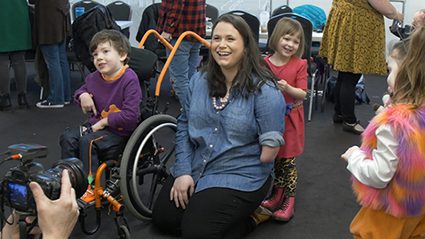
During a visit to Columbus Zoo and Aquarium, Chelsea Funk got a spark of inspiration that would ignite her senior fashion collection at Columbus College of Art & Design.
I was really inspired by how the animals are held captive,” says Funk (Fashion Design, 2018). “It made me think deeper about having a disability. How it can feel as if you’re always being watched — like you’re trapped, held captive.”
Funk was born with amniotic band syndrome, which means she was born without part of her left arm. She has always had trouble finding clothes that were fashionable and that fit well, and so was left to reconstruct her own clothes to make them work with her body.
“I used to buy those 99-cent travel sewing kits and I would cut clothes apart,” she says. “For one whole year, I never owned a pair of jeans.”
Turning negativity and darkness into something bright and optimistic is indicative of Funk’s style and approach to life.
CCAD Stories: Chelsea Funk by Josh Smukal (Film & Video, 2019) for the CCAD Student Agency.
An adaptive approach
Funk’s senior collection will make its debut at the 2018 CCAD Fashion Show on Friday, May 11. It consists of four looks of adaptive children’s wear made with fun fabrics and playful details. Each look is for a child who is differently abled and designed to meet the child’s individual ability and need. For example, a little girl with no thumbs loves dresses but has trouble putting on styles that are too heavy to hold up. Funk designed a half dress for her that has skirted front and T-shirt style back so it’s easy for her to pull on and off.
A child’s independence shouldn’t be limited by lack of function in clothing,” Funk says. “Children should be focused on having fun and being kids. They just want to have fun and comfortable.”
Another little girl with only one arm can’t manage buttons but wants to be independent — so Funk designed a shirt for her with a faux-button front, one that opens and closes via a system of magnets.
Funk put significant research and testing into finding alternative forms of closures that would make getting dressed easier both for the children and their parents. She also had to consider that her designs needed not to get in the way of any technology, equipment, or processes required in their day-to-day lives.
Her sweatshirt design for a wheelchair-bound little boy with cerebral palsy, for example, has a teddy bear on a pocket that unzips to reveal a port to make it easier for feedings and cleanings. A pair of side-close jeans makes it simpler for his mom to dress him in the wheelchair.
The styles are also focused on the fact that these clothes are for kids. Another child who has Down syndrome has trouble pulling things over her head, so Funk designed an easy-to-manage backpack that’s shaped like a teddy bear.
“My entire life is covered in neon pink fur right now,” she says, laughing.
Paying it forward to the children she’s designing for is partly motivated by her time at CCAD. Funk said sewing can be difficult for her because, “I can’t hold things as steadily as I’d like.” But, in each Fashion Design class she has taken, there has been a professor who has tried sewing with one arm and given her technique tips based on what they learned.
By the time senior year rolled around, Funk was more worried about the industry than her ability.
“I was so worried starting this collection,” Funk says. “Adaptive fashion is new and not recognized in the market, but getting to work with these families has made it absolutely worth it.”
After graduation, Funk would like to bring her unique style and outlook to a company that wants to start its own line of adaptive clothing, targeting a currently untapped market with huge potential. She points to people like her, born with disabilities, but also to wounded veterans, Paralympic athletes, and an aging adult population with changing needs, as future customers.
“Today, on the market, there are clothes for people who are plus-size, petite, tall, young, old, but nothing for those who are differently abled. I want to change that. Fashion should be an inclusive experience for every body, and everybody,” Funk says. “Even if just one company tapped into it, it would be a great benefit for everyone. I want to help open the fashion world for all.”
Photos by Josh Smukal (Film & Video, 2019) and Kyle Benson (Photography, 2018) for the CCAD Student Agency
Learn more about CCAD's Fashion Design program or apply today.
See Chelsea Funk in the news:
This piece is part of CCAD Stories, a series of profiles that feature a cross-section of Columbus College of Art & Design students spanning ages, majors, and style.
